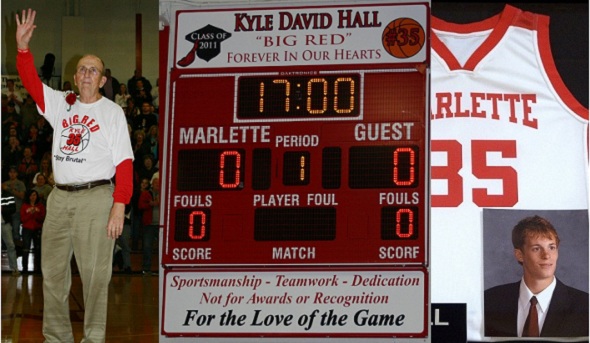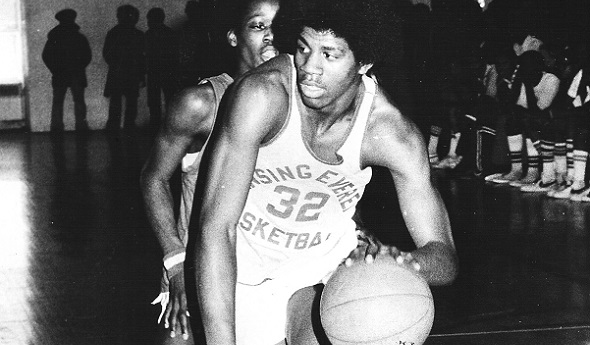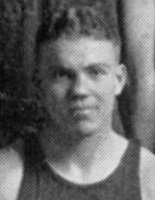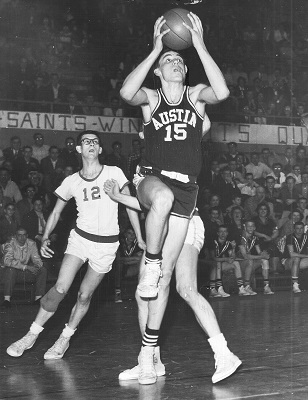
Their Place, Forever
February 9, 2012
By Geoff Kimmerly
Second Half editor
It’s surreal, Terry Reid said, humbling and overwhelming every time he sees his name hanging on Marlette’s gymnasium wall.
A little more than a month has passed since the school dedicated one of its most visible buildings to the longtime basketball coach. Thing is, Reid added, those honors usually are bestowed after a person has died – not while he’s still working the sideline, as Reid has done for Raiders teams over the last 40 years.
On the opposite wall hangs a new scoreboard, also dedicated Dec. 28. At the top is the name “Kyle Hall,” one of Reid’s eight grandchildren, a standout player who graduated last spring. Below hangs a photo of number 35, palming a basketball, gazing across the floor where Reid guides his junior varsity team through the same drills he’s been teaching for decades – and where he helped his grandson earn an opportunity to play at the college level.
“Every practice, … there’s a picture of him. And those eyes. I look up, and it kinda chokes me up,” Reid said.
“We’ve been blessed with grandkids who have let you know their feelings for them. ‘Hey Grandpa, see ya, I love ya.’ Those were the last words I heard from him, the day before he died.”
Reid wasn’t sure if he could return to coaching after that day, July 16, when during the early morning hours a car crash claimed Hall’s life as he drove home from a friend’s house.
Reid’s wife of 52 years, Jackie, convinced him to go back – both for himself, and for his grandson. And it seems just right they will be remembered in a place that has meant so much to both.
The plan comes together
Reid, 72, grew up in Redford Township, coached at Redford and then Detroit Benedictine for a short time before moving to Marlette in 1972. He’s coached a variety of teams, including the girls varsity for 21 seasons and the boys for 12 over two tenures, and hundreds of athletes including his daughter and Kyle’s mom Tammi, and currently Kyle’s little brother Dakota.
Kyle Hall got serious  about the game as a junior. At 6-foot-5 and at a Class C school, he was a post player – but realized he’d need better perimeter skills to play after high school. Reid never officially coached Kyle – Hall skipped Reid’s JV team to join the varsity as a sophomore. But that summer before senior year, Grandfather and Grandson got to work, a few hours three days a week, through tough times and good ones that come in part with coaching one’s child, or in this case, grandchild.
about the game as a junior. At 6-foot-5 and at a Class C school, he was a post player – but realized he’d need better perimeter skills to play after high school. Reid never officially coached Kyle – Hall skipped Reid’s JV team to join the varsity as a sophomore. But that summer before senior year, Grandfather and Grandson got to work, a few hours three days a week, through tough times and good ones that come in part with coaching one’s child, or in this case, grandchild.
After earning all-league and all-area honors in his final high school season, Hall was slated to join the Alma College men’s basketball team this fall – in fact, the Scots wear his initials on their pre-game warm-up shirts. Alma College also recently acquired a new scoreboard, and Kyle “told me one time … I’m going to light that sucker up,” Reid remembered.
That was Hall. He’d visit potential colleges with Tammi and his father Mike, and coaches would ask Kyle to list his strong point. Answer: Confidence. Weak point? Same answer. “He went out every game with the plan to win,” she said.
She recalled Kyle’s big feet: “He could run down the floor in three leaps.” Sports were his obvious first love. A three-sport athlete every year of high school, Kyle played football in fall, track and later golf in the spring. Every inch of his bedroom wall was covered either with pictures or clips from newspapers, his workout plan, and the terminology he was learning for nursing. Hall had passed his certification test to work as a nurse assistant two weeks before the crash. He had plans to pursue jobs at the hospitals in Marlette and Alma, and after getting his bachelor’s degree head to University of Michigan or Ferris State University for his master’s in nurse administration.
“When Kyle got something in his head, that’s what he’s going to do,” Tammi Hall said.
‘You just knew that he cared’
Terry Reid is an old-school basketball coach. Fundamentals rule. Defense first. Life has been basketball, golf, and family. He’s Marlette to the core – after all, the dog’s name is Red Raider Reid.
Prior to the gym dedication, the Huron Daily Tribune reported Terry’s various successes: a 315-149 girls varsity record, 100-98 with the boys varsity, and a combined seven District and five league championships. He also led the baseball team to a league title, coached in the football program and was athl etic director for 18 years on top of teaching a variety of subjects.
etic director for 18 years on top of teaching a variety of subjects.
The branches of his coaching tree spread throughout Michigan’s Thumb, and further. Reid estimates at least 40 former players have gone on to run their own teams. Brown City boys basketball coach Tony Burton and Bad Axe girls coach Brent Wehner both played for Reid, as did Kentucky Wesleyan College co-women’s coaches Caleb and Nicole Nieman. Closest to home, former players Chris Storm and his wife Cathy Storm now run Marlette’s boys and girls varsities, respectively.
“You just knew that he cared. … At the time you don’t realize it, but he becomes a true friend shortly after high school and throughout your career,” Chris Storm said.
“You always live through the tough times as well as the good times of teams. He’s been one who has persevered over the years. Everyone certainly goes through it; there are certain teams that don’t accomplish what they should, and that falls on the coach. But he’s always been able to keep his focus on the kids. That’s what we’re here for, and they know it.”
Like any grandparent, Reid takes pride in all of his grandchildren. An athletic bunch, he can recognize basketball potential – even in those who have chosen to play that other winter sport, hockey, instead.
But admittedly, Reid’s relationship with Hall took on another level because of their time together on the court. Storm’s son Alex teamed with Hall in 2010-11 and now plays at Rochester College in Rochester Hills, and Chris Storm recognized the similar tensions to his coaching his son.
But, “there’s certainly no question the time (Reid) spent with him and put in paid off for Kyle,” Storm said. “It was kinda neat they were able to share in that success at the end.”
He will be remembered
Reid said between 30 and 40 people came to the Halls’ home the night Kyle died.
His showing at the funeral home was scheduled to run from 1-9 p.m., but went until 10:20. After a small private funeral, the family went to the gym for a community ceremony – and found it packed.
“I really found out I wouldn’t want to be anywhere else. The support we received at that time, and to the present, has just been unreal,” Reid said. “They stuck with Mike and Tammi, and they still do.”
For the dedication, Kingston agreed to have its varsity girls and boys teams play at Marlette on the same night, instead of the usual JV/varsity doubleheader. Every Kingston player came into the stands and hugged Mike and Tammi. The Raiders boys team has had a bit of a tough one this winter coming off last season’s 17-5 finish – it was just 6-8 heading into Friday – but beat Kingston that night by 20.
In a small town, Storm said, something like Hall’s death brings somberness to the entire community. And, of course, it still hits the family hardest. But Reid is back coaching his junior varsity, with no plans to stop.
And after Dakota is done playing for the JV, Mike and Tammi stick around for the boys varsity games. They watch and support the friends and community that have supported them – and now in the building where they are surrounded by reminders that will continue to live on.
“He was so much fun to watch. I realize he was my own, so obviously I think higher of him. … But it was just so much fun to watch him play,” Tammi said.
“My husband and I talked quite a bit, and that’s where he’ll be remembered, on the basketball court. He packed a lot in those 19 years. ... I think he would think that’s pretty cool.”
PHOTOS courtesy of Reid and Hall families.
TOP: Terry Reid waves to the crowd during the Marlette gym dedication Dec. 28. (Middle) The scoreboard dedicated to Kyle Hall hangs on the eastern wall of the gym. (Right) Hall's retired jersey also hangs at the high school.
MIDDLE (1): A sign honoring Reid and remembering Hall hangs on the western wall of the gym.
MIDDLE (2): Hall (jumping) celebrates his team's outright league championship in 2011. Grandfather Terry Reid is among those pictured behind him.
MIDDLE (3): Reid (left) and Hall posed for a shot during the postgame celebration of that championship win.
BELOW: The full scoreboard, plus a photo of Hall, also were dedicated on Dec. 28.

'Retro' Award Rewards 1st Hoops Legends
January 4, 2017
By Ron Pesch
Special for Second Half
Before the start of the MHSAA’s 2009 Boys Basketball finals, Basketball Coaches Association of Michigan director Tom Hursey stopped by my seat at Michigan State University’s Breslin Center to say hello.
Our chat would alter a decade of my Michigan winters.
Somewhere between hello and goodbye, our chat included conversation on one of my favorite BCAM ventures. In 1981, the Michigan High School Basketball Coaches Association, as BCAM was once known, named its first “Mr. Basketball.” I was two years out of high school when Lansing Eastern’s Sam Vincent edged Eric Turner of Flint Central for that first award. Designed to honor the state’s top senior, the award was named in honor of Detroit Free Press writer Hal Schram. “The Swami,” as he was nicknamed, Schram began covering high school sports for the newspaper in 1945.
The 2009 selection was 6-foot-9 Derrick Nix of Detroit Pershing. I mentioned my affinity for the Mr. Basketball program to Tom, but stated that I always thought it a crime that the award didn’t start years earlier, at least when Michigan hoop fans became infatuated with a kid nicknamed “Magic.”
Earvin Johnson prepped at Lansing Everett and was the talk of the state in basketball circles before becoming a household name during his time at Michigan State and with the Los Angeles Lakers. Earlier this year, ESPN named Johnson the greatest point guard to ever play the game. Tom noted that “Magic” was really the inspiration for the “Mr. Basketball” award.
Then I posed a question to Tom.
What about creating a “new” award, designed to honor those greats from the past?
As my hobby of researching the history of high school sports in Michigan and beyond had grown over the years, I’d found the Great Lakes state had always produced shining stars on the basketball court. The crime was that the “Mr. Basketball” award hadn’t been launched many years before.
Harry Kipke, was perhaps the state’s first true basketball star. He won 12 varsity letters at Lansing Central and guided the basketball team to the semifinal round of the state tournament in 1920 as a senior, before heading to the University of Michigan where he earned letters in football, basketball and baseball. After stops at the University of Missouri and Michigan State, Kipke would serve as Michigan’s football coach, guiding the Wolverines to two national gridiron championships.
 As a junior, the basketball antics of Grand Rapids Union’s Royal “Red” Cherry captured the state’s attention when he led Union to the state basketball championship. Considered the best all-around player of the tournament, Cherry led the team to a second consecutive title as a senior. He, too, attended Michigan, earning laurels on the basketball court and the baseball diamond.
As a junior, the basketball antics of Grand Rapids Union’s Royal “Red” Cherry captured the state’s attention when he led Union to the state basketball championship. Considered the best all-around player of the tournament, Cherry led the team to a second consecutive title as a senior. He, too, attended Michigan, earning laurels on the basketball court and the baseball diamond.
Many other legends of the hardcourt populated Michigan’s past: Saginaw’s Ernie Thompson; the Burton brothers, M.C. and Ed, of Muskegon Heights; Detroit Pershing’s Ralph Simpson and Spencer Haywood; Dave DeBusschere of Detroit Austin Catholic; Willie Betts and Blanche Martin of River Rouge; Ron Kramer of East Detroit; Benton Harbor’s Chet Walker and L.C. Bowen.
After a few weeks of research, discussion and thought, Tom agreed, and over the next several months the framework for the “Retro Mr. Basketball” project was developed
The idea was to try and mimic the current model. Only seniors, and their high school basketball careers, should be considered. While any “senior” player would be eligible, a ballot of the state’s elite would comprise the candidates for the award. Like their modern-day equivalents, where the events of life that would follow high school graduation had yet to occur, post-high school life would be disregarded as much as possible for “Retro” candidates.
Finally, the program would follow a 10-year arc, kicking off in the spring of 2010. This December marks my eighth year of research tied to the mission. Two more will follow.
Since the Schram “Mr. Basketball” award began in 1981, the “Retro” award would honor basketball players from the years 1920 through 1980. That first year, a ballot comprised of players from the years that ended in zero - 1920, 1930, 1940, 1950, 1960, 1970 and 1980 – was created. A senior for each year would be named the winner of the “Retro” award. That meant with the selection of “Mr. Basketball” and the six “Retro” winners for the years 1929, 1939, 1949, 1959, 1969 and 1979, scheduled for the spring of 2019, BCAM would be able to point to a combined list of Mr. Basketballs totaling 100 of the state’s finest.
To identify each year’s award winner, a committee of veteran BCAM members was formed to study a ballot of candidates and select a winner.
Technology, combined with scanning old-fashioned reels of microfilm, has helped with research of potential candidates. In those very early years, personal statistics were rarely kept. Rather, an assessment of a player’s skills, tied to the position he played, often served as a means to identify an area’s top athletes. Tournament play was often the only time an athlete’s abilities were on display to a larger audience. Scouring newspaper articles for all-tournament teams and yearbooks for additional details and years of study helped uncover the state’s top senior players. Understanding the game and its evolution was important. The center jump after each basket emphasized the importance of a tall, skilled center in those games played before the winter of 1938-39.
Beginning in 1935, all-state teams began to appear in state newspapers. Eventually, the Detroit Free Press, the Detroit Times, the Detroit News, The Associated Press and even United Press International became involved in identifying the state’s top basketball players and naming all-state squads. Much work is involved in parsing the 15,811 names (not including honorable mentions) found in those lists. When duplicates are removed, the names of 8,430 prep players remain spread over the 61 years that mark the “Retro” field of possible candidates.
Research to identify seniors, players named by multiple media outlets, and mini biographies are compiled for the top players. The field of candidates is then narrowed to 10 or fewer. Over state championship weekend, the ballots are brought to the BCAM committee for discussion, and finalists are named for each year. Finally, one player is named for each eligible season.
Like the modern day award, the selection may create some controversy. Some amazing ballplayers have landed on the finalist list, but were denied the Hal Schram Mr. Basketball award: Traverse City’s Dan Majerle, Roy Marble of Flint Beecher, Detroit Southwestern’s Jalen Rose, Detroit Northern’s Derrick Coleman and Draymond Green of Saginaw are among a few.
 The same applies to the “Retro” list. Fennville’s Richie Jordan, Robert “Bubbles” Hawkins from Detroit Pershing, Dennis Bankey of Detroit St. Thomas, Bill Chmielewski of Detroit Redeemer, Highland Park’s Terry Duerod and Detroit Kettering’s Lindsay Hairston all have been honored on the finalist lists, but fell short of the top prize.
The same applies to the “Retro” list. Fennville’s Richie Jordan, Robert “Bubbles” Hawkins from Detroit Pershing, Dennis Bankey of Detroit St. Thomas, Bill Chmielewski of Detroit Redeemer, Highland Park’s Terry Duerod and Detroit Kettering’s Lindsay Hairston all have been honored on the finalist lists, but fell short of the top prize.
In many cases, Michigan was loaded with prep talent – it’s tough to name Roy Marble Mr. Basketball when Flint Northwestern’s Glen Rice was on the same ballot, or Rose the state’s best when Country Day’s Chris Webber was another candidate. While the “Fennville Flash” amazed the state with his eye-popping statistics in 1965, Bowen led Benton Harbor to back-to-back Class A titles. Named an all-state basketball player as a junior, Hairston grew an inch and improved his game as a senior, but Pontiac Central’s “Campy” Russell dominated headlines that season, and was the “Retro” Mr. Basketball selection for 1971.
In some cases, it’s a challenge to look at the final balloting results without judging selections based on future basketball success. That certainly is the case with 2008. That season, Michigan’s Mr. Basketball award went to 6-foot guard Brad Redford, who posted incredible back-to-back high school seasons at Frankenmuth. Runner-up to the award that year was Saginaw’s Green. Considering Green’s success in the NBA, that’s hard for many to believe.
While the debates may never be settled, the beauty of Schram and “Retro” Mr. Basketball balloting can be found in the argument. With those disputes, people recall, research and learn about Michigan’s incredible prep basketball past.
The remaining three years of the “Retro” project will include many more legends of Michigan High School basketball, including, among others, DeBusschere, Walker, Haywood and Simpson.
This season, that “Magic” kid will be one of the names among the mix. Forty years after high school graduation, will he earn the honor that eluded him in high school, only because the honor didn’t yet exist?
 Ron Pesch has taken an active role in researching the history of MHSAA events since 1985 and began writing for MHSAA Finals programs in 1986, adding additional features and "flashbacks" in 1992. He inherited the title of MHSAA historian from the late Dick Kishpaugh following the 1993-94 school year, and resides in Muskegon. Contact him at [email protected] with ideas for historical articles.
Ron Pesch has taken an active role in researching the history of MHSAA events since 1985 and began writing for MHSAA Finals programs in 1986, adding additional features and "flashbacks" in 1992. He inherited the title of MHSAA historian from the late Dick Kishpaugh following the 1993-94 school year, and resides in Muskegon. Contact him at [email protected] with ideas for historical articles.
PHOTOS: (Top) Lansing Everett’s Earvin Johnson drives around a defender during his celebrated high school career. (Middle) Grand Rapids Union’s Royal “Red” Cherry. (Below) Detroit Austin Catholic’s Dave DeBusschere drives to the hoop as an opponent gets in position to rebound. (Photos from MHSAA and Ron Pesch historical files.)

